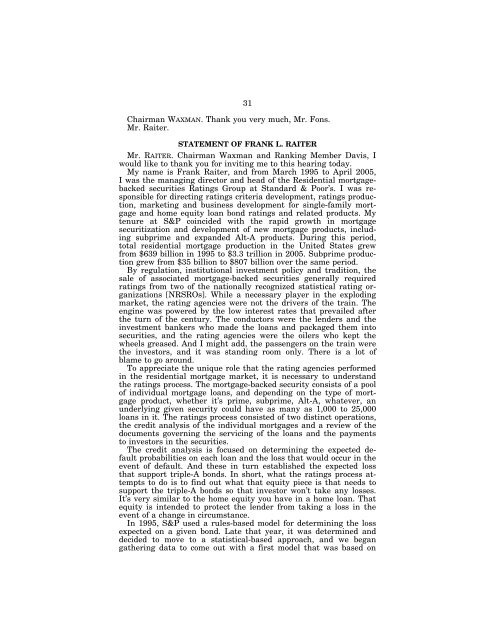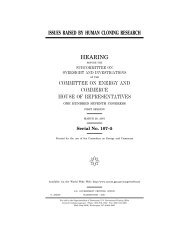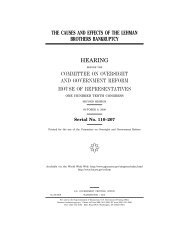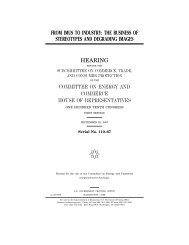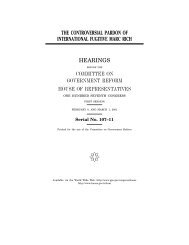CREDIT RATING AGENCIES AND THE FINANCIAL CRISIS ...
CREDIT RATING AGENCIES AND THE FINANCIAL CRISIS ...
CREDIT RATING AGENCIES AND THE FINANCIAL CRISIS ...
- No tags were found...
You also want an ePaper? Increase the reach of your titles
YUMPU automatically turns print PDFs into web optimized ePapers that Google loves.
31Chairman WAXMAN. Thank you very much, Mr. Fons.Mr. Raiter.STATEMENT OF FRANK L. RAITERMr. RAITER. Chairman Waxman and Ranking Member Davis, Iwould like to thank you for inviting me to this hearing today.My name is Frank Raiter, and from March 1995 to April 2005,I was the managing director and head of the Residential mortgagebackedsecurities Ratings Group at Standard & Poor’s. I was responsiblefor directing ratings criteria development, ratings production,marketing and business development for single-family mortgageand home equity loan bond ratings and related products. Mytenure at S&P coincided with the rapid growth in mortgagesecuritization and development of new mortgage products, includingsubprime and expanded Alt-A products. During this period,total residential mortgage production in the United States grewfrom $639 billion in 1995 to $3.3 trillion in 2005. Subprime productiongrew from $35 billion to $807 billion over the same period.By regulation, institutional investment policy and tradition, thesale of associated mortgage-backed securities generally requiredratings from two of the nationally recognized statistical rating organizations[NRSROs]. While a necessary player in the explodingmarket, the rating agencies were not the drivers of the train. Theengine was powered by the low interest rates that prevailed afterthe turn of the century. The conductors were the lenders and theinvestment bankers who made the loans and packaged them intosecurities, and the rating agencies were the oilers who kept thewheels greased. And I might add, the passengers on the train werethe investors, and it was standing room only. There is a lot ofblame to go around.To appreciate the unique role that the rating agencies performedin the residential mortgage market, it is necessary to understandthe ratings process. The mortgage-backed security consists of a poolof individual mortgage loans, and depending on the type of mortgageproduct, whether it’s prime, subprime, Alt-A, whatever, anunderlying given security could have as many as 1,000 to 25,000loans in it. The ratings process consisted of two distinct operations,the credit analysis of the individual mortgages and a review of thedocuments governing the servicing of the loans and the paymentsto investors in the securities.The credit analysis is focused on determining the expected defaultprobabilities on each loan and the loss that would occur in theevent of default. And these in turn established the expected lossthat support triple-A bonds. In short, what the ratings process attemptsto do is to find out what that equity piece is that needs tosupport the triple-A bonds so that investor won’t take any losses.It’s very similar to the home equity you have in a home loan. Thatequity is intended to protect the lender from taking a loss in theevent of a change in circumstance.In 1995, S&P used a rules-based model for determining the lossexpected on a given bond. Late that year, it was determined anddecided to move to a statistical-based approach, and we begangathering data to come out with a first model that was based onVerDate 11-MAY-2000 12:35 Aug 24, 2009 Jkt 000000 PO 00000 Frm 00035 Fmt 6633 Sfmt 6633 U:\DOCS\51103.TXT KATIE PsN: KATIE


